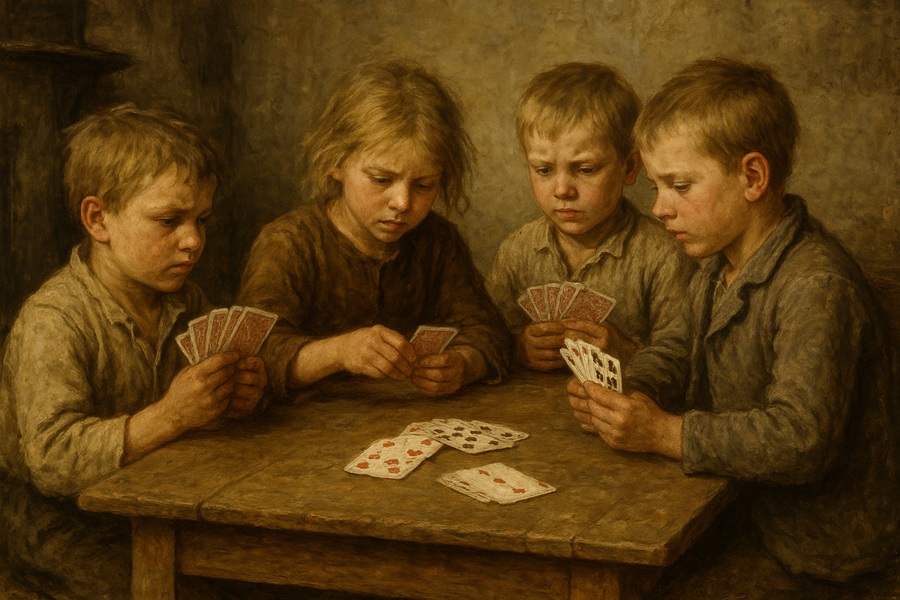- 13 de October de 2025
- No Comment
- 10 minutes read
Under the “bridge” syndrome

Image generated by AI

That bridge happens to be a game for the rich does not mean that everyone who plays it is rich. Logically speaking, that would be a faulty syllogism: “The rich play bridge; Socrates plays bridge; therefore, Socrates is rich”. Likewise, to conflate both notions—playing bridge and being rich—as if they were a one-to-one relation, is to fail to distinguish conceptually between the cultural and the social: a kind of magical thinking.
Seen from this angle, the error seems obvious enough, though it does not always manifest itself so clearly in our reasoning. In education, for instance, analysing or judging from an academic perspective is not the same as doing so from a social one. An education system can be academically successful yet socially abject; or it may be socially successful—at least in the sense of having universalised schooling—while being an outright academic fraud. If we fail to distinguish between these two dimensions, we inevitably end up in a conceptual muddle, a syncretic stew befitting the saying “all cats are grey in the dark”. And, staying within the realm of popular proverbs, one might also invoke the adage, “It’s an ill wind that blows nobody any good”.
What is truly exasperating is witnessing how, in the so-called educational “debate”—more often a brawl than a discussion—participants repeatedly evade the core issues, stubbornly perpetuating this very confusion. The result is a fertile ground for misunderstandings, fallacies, and paralogisms which, beyond their demagogic use, have devastating consequences for both the education system and society as a whole.
Virtually all international reports concur that Spain has experienced a more than noticeable decline in academic standards in recent years. We seem to be living in a permanent present of “each day worse than the last, yet better than the next”, with no sign of any break in the trend. The level of knowledge and competence among students is now lower than that of graduates from previous generations, following a sustained and traceable downward curve. Reading comprehension among Spanish university students has dropped by ten points in a decade—the university students! —placing them not only below the OECD average, but also below sixth form students in countries such as Sweden, Finland or Japan. This is not scaremongering, but evidence derived from data presented in those studies, corroborated by the perceptions of teachers and of increasingly wider segments of society.
Faced with this sobering reality, the standard official response is that, in the past—whenever that “past” may have been—school enrolment rates were much lower. Ergo, it is only natural that now, with universal schooling, the average “grade” should have dropped, since in the past results reflected only a (financially) “privileged” minority.
Whether we are referring to PIAAC—testing the entire population over sixteen in ten-year age brackets—or to standardised assessments such as PISA, PIRLS, or TIMSS, taken at regular intervals and ages, the refrain remains the same. Yet schooling has been universal for some forty years now, and the downward trend persists. We are not claiming that social factors are irrelevant to this educational deterioration, but we do seem to have settled into a kind of resigned fatalism—a half-hearted moral imperative that feels satisfied with universal schooling, the appearance of social success, while disregarding its academic dimension or writing it off entirely, along with the social effects of the widening academic gap. If mere attendance suffices for graduation, we may infer that learning itself is secondary—that what matters is being schooled, not educated. And yes, schooling is a necessary condition, but it is hardly sufficient.
If we are to make comparisons—and that, after all, is precisely what these tests are designed for—there are certain things we must be absolutely clear about. Conceptual discrimination is one of them. We must know what we are talking about, and what exactly we are comparing. Are we speaking of the academic health of the education system, or of the social reach of schooling? And of course, what do we mean by these terms?
It is evident that a system in which only 50% of sixteen-year-olds are enrolled and the average grade is seven is not equivalent—academically or socially—to one in which 99.9% are enrolled and the average grade is four. Nor should their respective outcomes be interpreted in the same way. One cannot cook a lobster and a steak in the same pot. Well, one can—but one should hardly be surprised by the resulting mess.
Of the first system we would say that it is academically successful but socially unjust—a class-based aggression, in short. The second, by contrast, would represent an academic fiasco but a success in terms of social inclusion—though only formally so: everyone of school age is inside the system, but to what end remains unclear. An academic farce, or, if you prefer, a placebo.
That something must be done is self-evident; equally clear is that the necessary course of action will differ in each case, for the nature of their respective flaws is fundamentally distinct. In the first, at least from a democratic perspective, the task is to extend the academically successful model to the entire population—without reductions or bargain-basement compromises. In the second, the objective is equally unmistakable: to ensure that the socially inclusive school structure fulfils its proper academic purpose—to teach. No social restrictions, no sugar-coated academic deceit.
This was, for instance, the model of Spain’s Second Republic: to expand schooling in order to bring culture—until then the privilege of a minority—to the entire population. Academically, little changed; with its ups and downs, it failed for well-known reasons. The same, in its own way and with its own lights and shadows, could be said of the 1970 General Education Act (Ley General de Educación). Regardless of ideology, it sought to combine social expansion with academic rigour. By contrast, the 1990 LOGSE was its controlled demolition—controlled, needless to say, by those who held the reins. From that point onward, the process resembled a game of hopscotch, square by square, each player convinced that we were learning to play bridge.
What is unacceptable is the crude argument that universal schooling accounts for the decline in academic performance. Academically speaking, to assume that success and failure must necessarily follow a worse pattern when 100% of the population is enrolled than when only 50% are, is to imply that the poor are inherently less intelligent than the rich—a form of social Darwinism as pernicious as it is reactionary, particularly in its contemporary guise of feigned benevolence. Besides, it has been repeatedly disproved in practice.
The former USSR was the unrivalled chess superpower precisely because it had, by itself, more registered players than the rest of the world combined. Quality arises from quantity. The rest is nonsense. Yet such quality does not emerge from nothing: it must be taught and demanded. We must create schooling, not merely build schools; otherwise, no amount of quantity will yield quality—save, perhaps, a few exceptions, like those who win the lottery.
Why, then, is the universalisation of education producing the opposite effect? Why, as the schooling population expands, do the lower results increase while the higher ones diminish? Does this not tell us something?
If we are being charitable, we might suggest that the official education gurus and politicians suffer from what could be called “bridge syndrome”: the belief that mere enrolment is sufficient for true education, and that all is water under the bridge. The same one-to-one fallacy, repeated once more. Sadly, as we know, neither the clothes make the man, nor does playing bridge make one rich.
Or we might be more trenchant and suggest that, yes, of course, the diploma will be the same for rich and poor alike—but since the latter are never expected to set foot in an elegant bridge club to display their skills, they may as well make do with a game of Snakes and Ladders, masquerading as bridge. After all, they will scarcely notice the difference. Cheaper? Perhaps not even that—but the cause, it seems, warrants the effort.
That the educational waters are turbulent is beyond doubt. Whether our assessments are charitable or biting can, in turn, be gauged by observing the fishermen reaping their harvest in these stormy seas. In other words: cui prodest? Who is profiting from this situation?
And let each one see and understand according to their own sight and understanding.
Source: educational EVIDENCE
Rights: Creative Commons

